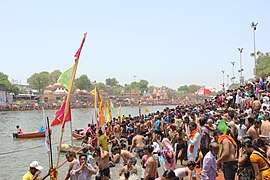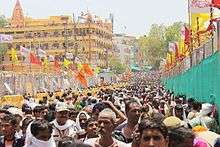Ujjain
Ujjain (/uːˈdʒeɪn/ (![]()
Ujjain Ujjayini, Avanti, Avantika, Avantikapuri | |
|---|---|
Metropolitan City | |
Ram ghat and Kshipra river in Ujjain | |
| Nickname(s): Mahakal Ki Nagri, Kumbh Nagri, The City of Temples | |
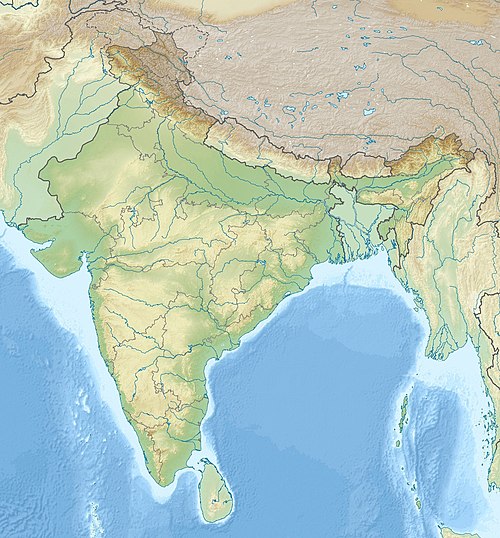 Ujjain Location in India 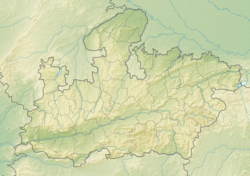 Ujjain Ujjain (Madhya Pradesh) | |
| Coordinates: 23.17°N 75.79°E | |
| Country | |
| State | Madhya Pradesh |
| Region | Malwa |
| District | Ujjain |
| Government | |
| • Type | Municipal council |
| • Body | Ujjain Municipal Corporation |
| • Mayor | Meena Jonwal (BJP) |
| • Municipal Commissioner | Rishi Garg (IAS) |
| Area | |
| • Metropolitan City | 157 km2 (61 sq mi) |
| • Metro | 745 km2 (288 sq mi) |
| Area rank | 5th in M.P. |
| Elevation | 494 m (1,621 ft) |
| Population (2011) | |
| • Metropolitan City | 515,215[2] |
| • Rank | 5th in M.P. |
| • Metro | 672,566 |
| Languages | |
| • Official | Hindi |
| • Other | Malvi |
| Time zone | UTC+5:30 (IST) |
| PIN | 456001, 456003, 456006, 456010, 456661, 456664. |
| Telephone code | +91734 |
| Vehicle registration | MP-13 |
| Climate | Cfa (Köppen) |
| Precipitation | 900 millimetres (35 in) |
| Avg. annual temperature | 24.0 °C (75.2 °F) |
| Avg. summer temperature | 31 °C (88 °F) |
| Avg. winter temperature | 17 °C (63 °F) |
| Website | ujjain |
An ancient city situated on the eastern bank of the Kshipra River, Ujjain was the most prominent city on the Malwa plateau of central India for much of its history. It emerged as the political centre of central India around 600 BCE. It was the capital of the ancient Avanti kingdom, one of the sixteen mahajanapadas. It remained an important political, commercial and cultural centre of central India until the early 19th century, when the British administrators decided to develop Indore as an alternative to it. Ujjain continues to be an important place of pilgrimage for Shaivites, Vaishnavites and followers of Shakta.[4]
Ujjain has been selected as one of the hundred Indian cities to be developed as a smart city under PM Narendra Modi's flagship Smart Cities Mission.[5]
History
GU
Excavations at Kayatha (around 26 km from Ujjain) have revealed chalcolithic agricultural settlements dating to around 2000 BCE.[6] Chalcolithic sites have also been discovered at other areas around Ujjain, including Nagda, but excavations at Ujjain itself have not revealed any chalcolithic settlements. Archaeologist H. D. Sankalia theorized that the chalcolithic settlements at Ujjain were probably destroyed by the Iron Age settlers.[7]
According to Hermann Kulke and Dietmar Rothermund, Avanti, whose capital was Ujjain, "was one of the earliest outposts in central India" and showed signs of early incipient urbanisation around 700 BCE.[8] Around 600 BCE, Ujjain emerged as the political, commercial and cultural centre of Malwa plateau.[9]
The ancient walled city of Ujjain was located around the Garh Kalika hill on the bank of river Kshipra, in the present-day suburban areas of the Ujjain city. This city covered an irregular pentagonal area of 0.875 km2. It was surrounded by a 12 m high mud rampart. The archaeological investigations have also indicated the presence of a 45 m wide and 6.6 m deep moat around the city.[10] According to F. R. Allchin and George Erdosy, these city defences were constructed between 6th and 4th centuries BCE.[11] Dieter Schlingloff believes that these were built before 600 BCE.[10] This period is characterised by structures made of stone and burnt-brick, tools and weapons made of iron, and black and red burnished ware.[11]
According to the Puranic texts, a branch of the legendary Haihaya dynasty ruled over Ujjain.[12]
Ancient period

In the 4th century BCE, the Mauryan emperor Chandragupta annexed Avanti to his empire.[13] The edicts of his grandson Ashoka mention four provinces of the Mauryan empire, of which Ujjain was the capital of the Western province.[14] During the reign of his father Bindusara, Ashoka served as the viceroy of Ujjain,[15] which highlights the importance of the town.[9] As the viceroy of Ujjain, Ashoka married Devi, the daughter of a merchant from Vedisagiri (Vidisha).[16] According to the Sinhalese Buddhist tradition, their children Mahendra and Sanghamitra, who preached Buddhism in modern Sri Lanka, were born in Ujjain.[17]
From the Mauryan period, Northern Black Polished Ware, copper coins, terracotta ring wells and ivory seals with Brahmi text have been excavated at Ujjain.[11] Ujjain emerged as an important commercial centre, partially because it lay on the trade route connecting north India to the Deccan, starting from Mathura. It also emerged as an important center for intellectual learning among Jain, Buddhist and Hindu traditions.[9] After the Mauryans, Ujjain was controlled by a number of empires and dynasties, including local dynasties, the Shungas, the Western Satraps, the Satavahanas, and the Guptas.[9]
Ujjain remained as an important city of the Guptas during the 4th and the 5th centuries. Kalidasa, the great Indian classical poet of the 5th century who lived in the times of the Gupta king Vikramaditya wrote his epic work Meghadūta in which he describes the richness of Ujjain and its people.[18] In the 6th century CE the Chinese pilgrim Xuanzang visited India. He describes the ruler of Avanti as a king who was generous to the poor and presented them with gifts.[19]
.jpg)
Bharthari is said to have written his great epics, Virat Katha, Neeti Sataka, the love story of Pradyot Princess Vasavadatta and Udayan in Ujjayini, as the city was called during his times. The writings of Bhasa are set in Ujjain, and he probably lived in the city.[20] Kalidasa also refers to Ujjain multiple times, and it appears that he spent at least a part of his life in Ujjain.[21] Mrichchhakatika by Shudraka is also set in Ujjain.[22] Ujjain also appears in several stories as the capital of the legendary emperor Vikramaditya. Somadeva's Kathasaritsagara (11th century) mentions that the city was created by Vishwakarma, and describes it as invincible, prosperous and full of wonderful sights.[23]
Medieval period
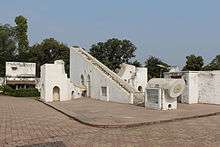
The Paramaras (9th-14th century CE) shifted the region's capital from Ujjain to Dhar.[9] In 1235 CE, Iltutmish of Delhi Sultanate plundered the city, and destroyed its temples.[9] With the decline of the Paramara kingdom, Ujjain ultimately came under the Islamic rule, like other parts of north-central India. The city continued to be an important city of central India. As late as during the times of the Mughal vassal Jai Singh II (1688-1743), who constructed a Jantar Mantar in the city, Ujjain was the largest city and capital of the Malwa Subah.[24]
Modern period
During the 18th century, the city briefly became the capital of Scindia state of the Maratha confederacy, when Ranoji Scindia established his capital at Ujjain in 1731. Madhadji Shinde constructed a grand palace with a hundred rooms around which the Maratha sardars constructed their own mansions. Ruined and destroyed temples were restored and newer ones were built.[25] But his successors moved to Gwalior, where they ruled the Gwalior State in the latter half of the 18th century. The struggle of supremacy between the Holkars of Indore and Scindias (who ruled Ujjain) led to rivalry between the merchants of the two cities.[26] On 18 July 1801, the Holkars defeated the Scindias at the Battle of Ujjain. On 1 September, Yashwantrao Holkar entered the city, and demanded a sum of 15 lakh rupees from the city. He received only 1/8th of this amount; the rest was pocketed by his officers. A force sent by Daulat Scindhia later regained control of Ujjain.[27] After both Holkar and Scindias accepted the British suzerainty, the British colonial administrators decided to develop Indore as an alternative to Ujjain, because the merchants of Ujjain had supported certain anti-British people. John Malcolm, the British administrator of Central India, decided to reduce the importance of Ujjain "by transferring a great part of that consequence it now enjoys to the Towns of Indore and Rutlam cities, which are and will continue more under our control."[26]
After the independence India, Ujjain became a part of the Madhya Bharat state. In 1956 Madhya Bharat was fused into the State of Madhya Pradesh.
Geography
Ujjain is located in the west-central part of India, and is north of the upper limit of the Vindhya mountain ranges. Located on the Malwa plateau, it is higher than the north Indian plains and the land rises towards the Vindhya Range to the south. Ujjain's co-ordinates are 23°10′N 75°46′E with an average elevation of 494 m (1620 ft).[28] The region is an extension of the Deccan Traps, formed between 60 and 68 million years ago[29][30] at the end of the Cretaceous period. The city is on the bank of the river Shipra which flows into the nearby Chambal. The tropic of cancer also passes through a temple named Karkoteshwar, located near Harsiddhi Mandir in Ujjain. Climate of the city features an typical version of the humid subtropical climate (Köppen Cwa). Summers usually starts by the middle of March which lasts up until late June. During which temperatures normally reaches up to 45 °C, with average maximum peaking in May with 41 °C. Monsoon starts in late June and ends in late September. These months see about 36 inches (914 mm) of precipitation, frequent thunderstorms and flooding. This season usually features wet phase of comfortable with average temperatures around 24 °C (76 °F) but this is accompanied with frequent downpours. This wet phase is followed by dry phase which results in humid weather with high temperatures. Temperatures rise again up to late October when winter starts, which lasts up to early March. Winters are cool, dry and sunny with occasional cold snaps during which temperature may drop to close to freezing (0° to 3°). Otherwise temperatures are very much comfortable, with average daily temperatures around 16 °C (61 °F).
Demographics
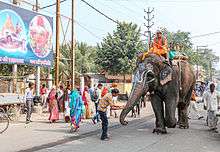
According to the 2011 census, Ujjain had a population of 515,215, comprising 265,291 males and 249,924 females, giving a sex ratio of 942 per 1000. The overall literacy rate was 85.55%, with male literacy at 91.16% and female literacy at 79.62%.[2]
Government and jurisdiction
Most of the regions surrounding the city are administered by the Ujjain Municipal Corporation (UMC). The city is administered by a Divisional Commissioner and a Collectorate Office as well as the Mayor. They are responsible for the town and Country Planning Department, Forest Department, Public Health Engineering, Public Works Department and MP Electricity Board.[31][32]
Ujjain has been a metropolitan municipality with a mayor-council form of government. The Ujjain Municipal Corporation (UMC) was established in 1956 under the Madhya Pradesh Nagar Palika Nigam Adhiniyam. The UMC was established in 1886 as Nagar Palika, but the Municipal Corporation of Ujjain was declared on a par with the Gwalior Municipal Corporation. The UMC is responsible for public education, correctional institutions, libraries, public safety, recreational facilities, sanitation, water supply, local planning and welfare services. The mayor and councillors are elected to five-year terms.[33] [34]
The Ujjain Development Authority, also known as UDA, is the urban planning agency serving Ujjain. Its headquarters are located in the Bharatpuri area of Ujjain. It was established under the Madhya Pradesh Town and Country Planning Act, 1973.[35]
Ujjain Lok Sabha constituency is one of the 29 Lok Sabha constituencies in Madhya Pradesh state in central India. This constituency came into existence in 1951 as one of the 9 Lok Sabha constituencies in the erstwhile Madhya Bharat state. It is reserved for the candidates belonging to the Scheduled Castes since 1966. This constituency covers the entire Ujjain district and part of Ratlam district. Previously, Dr. Chintamani Malviya of the Bharatiya Janata Party was the member of parliament who won in the 2014 Indian general elections.[36]
The Current Member of Parliament from Ujjain is Mr. Anil Firojiya ( BJP ) in the recently concluded Lok Sabha Election 2019.[37]
Culture
Some of the notable sacred places in the city include:
- Chintaman Ganesh temple
- Gopal Mandir, built by Sawai Jai Singh of Jaipur
- ISKCON temple
- Kal Bhairav temple
- Mahakaleshwar Jyotirlinga, an ancient temple that was destroyed by Iltutmish and then restored by the Scindias of Gwalior
- Mangalnath Temple, tropic of cancer passes through this temple
Other historic places in Ujjain include:
- Ved Shala
- Sandipani Ashram
- Kaliadeh Palace
Simhastha
The Ujjain Simhastha is a mass Hindu pilgrimage, and one of the fairs recognised as Kumbh Melas.[3] During the Simhastha, Hindus gather to bathe in a sacred river. At Ujjain, it is held once every 12 years, on the banks of Kshipra river.[3] It is also known as Simhastha, when it falls during Jupiter's stay in Leo of Simha. The latest Simhastha was held in Ujjain from 22 April 2016 to 21 May 2016.[3]
Education
University
- Avantika University
- Maharshi Panini Sanskrit University
- Vikram University
- Colleges in Ujjain
Medical Colleges
Engineering Colleges
Schools
- [[]]Nirmala Convent Higher Secondary School
- St. Mary's Convent School
- St Paul's Higher Secondary School
- Takshshila Junior College
- Ujjain Public School
Industry
The Government of Madhya Pradesh has allotted 1,200 acres for the development of an industrial area on the Dewas-Ujjain Road near Narwar village. Originally named "Vikramaditya Knowledge City", the area was envisaged as an educational hub. Due to diminished investment prospects, it was renamed to "Vikram Udyog Nagari" ("Vikram Industrial City"). As of 2014, the government has conceptualised it as a half-industrial, half-educational area. The stakeholders in the project include the state government and the Delhi Mumbai Industrial Corridor (DMIC) Trust.[38]
Transportation
Airport
Ujjain does not have any airport but has an airstrip on Dewas road which is used for air transport purposes. In 2013, the Government of Madhya Pradesh started a Ujjain-Bhopal air services as a joint venture with Ventura AirConnect. Due to very low booking, the ambitious project was scrapped. The main reason for the failure of the plan was due to improper timing of flights. The nearest airport is the Devi Ahilyabai Holkar International Airport at Indore (57 km).
Railway

Ujjain Junction is the main railway station of Ujjain, and it is directly or indirectly well-connected to all the major railway stations in India.[39] It lies on the Ratlam–Bhopal, Indore–Nagda and Guna–Khandwa route. To the west it is connected to Ratlam Junction, to the north it is connected with Nagda Junction, to the east it is connected with Maksi Junction, Bhopal Junction, and to the south it is connected to Indore Junction BG, Dewas Junction Harda BG.[40][41]
C&W Training Centre/Ujjain/WR
There are five railway stations in the Ujjain city and its suburbs:
| Station name | Station code | Railway zone | Total platforms |
|---|---|---|---|
Ujjain Junction |
UJN | Western Railway | 08 |
| CNN | Western Railway | 2 | |
Matana Buzurg (abandoned) |
MABG | Western Railway | 2 |
| PLW | Western Railway | 2 | |
| VRG | Western Railway | 2 | |
Tajpur |
TJP | Western Railway | 2 |
Road

Dewas Gate Stand and Nana Kheda Bus Stand are the two bus stands in the city that provide service to destinations located in the states. A large number of state run private buses are available for Ahmedabad, Jaipur, Ajmer, Khajuraho, Harda, Indore, Bhopal, Pune, Mumbai, Kota, Mandu, Jhalawar and various other locations. The city has a well connected road network including Indore Road, Badnagar Road, Dewas Road, Agar Road, Nagda Road and Maksi Road. There are three state highways; 18 connects to Ahmedabad, 17 connects to jaora and 27 connects to Indore.[42][43][44][45]
Other regional highways passing through the city are:
Local transport
Ujjain depends on an extensive network of auto rickshaws, city busses, private taxis and Tata Magic, that operate throughout the city, connecting one part with another. UMC has recently introduced city buses with a public private partnership project as the city was identified urban agglomerations with less than 1 million population under the Jawaharlal Nehru National Urban Renewal Mission.[46][47]
Sports
Cricket is one of the most popular sports in the city. Ujjain is also home to the Ujjain Divisional Cricket Association which is affiliated to BCCI. The city does not have any big stadium, but hosted Ranji Trophy matches at Pipe Factory Ground in 1977 and 1980.[48]
Kite flying is another popular activity in the city around Makar Sakranti.[49]
Smart city
Ujjain city was shortlisted under the Government of India's flagship programmes Smart Cities Mission. Under the mission, UMC ( Ujjain Municipal Corporation) shall participate in the smart cities challenge by Ministry of Urban Development. As part of this, UMC is preparing a Smart City Proposal (SCP). SCP will include smart city solutions based on the consultations to be held with the key stakeholders of the city. UMC invited the suggestions from citizens of Ujjain to make ‘Ujjain as a smart city’. The citizens were able to post their views pertaining to basic services such as water supply, sewerage, urban transport, social infrastructure and e-governance.[50]
Notable people
Notable people who were born or lived in Ujjian include:
- Kālidāsa
- Devi (wife of Ashoka)
- Shivmangal Singh Suman
- Shreeram Shankar Abhyankar
- Bharthari
- Yashoda Devi
- Vivian Dsena
- Thawar Chand Gehlot
- Gundecha Brothers
- Satyanarayan Jatiya
- Hukam Chand Kachwai
- Sachida Nagdev
- Naman Ojha
- Paramartha
- Sartaj Singh
- Saumya Tandon
- Vikramaditya
- Juhi Parmar
- Goverdhan Lal Oza
- Sharma Bandhu
- V. S. Wakankar
References
- "District Census Handbook - Ujjain" (PDF). Census of India. p. 12,22. Retrieved 6 December 2015.
- "Cities having population 1 lakh and above" (PDF). Census of India 2011. Retrieved 17 September 2019.
- "Ujjain: As Kumbh draws to a close, devotees throng Kshipra for 'shahi snan'". Indian Express. 21 May 2016.
- Jacobsen, Knut A. (2013). Pilgrimage in the Hindu Tradition: Salvific Space. Routledge. p. 128. ISBN 978-0-41559-038-9.
- http://www.firstpost.com/business/why-only-98-cities-instead-of-100-announced-all-questions-answered-about-smart-cities-project-2410576.html
- P. K. Basant (2012). The City and the Country in Early India: A Study of Malwa. Primus. pp. 78–81. ISBN 9789380607153.
- Pranab Kumar Bhattacharyya 1977, pp. 1-2.
- Kulke, Hermann; Rothermund, Dietmar (2004). A History of India. Psychology Press. pp. 50–51. ISBN 978-0-41532-920-0.
- Trudy Ring; Noelle Watson; Paul Schellinger, eds. (2012). Asia and Oceania: International Dictionary of Historic Places. Routledge. pp. 835–837. ISBN 9781136639791.
- Dieter Schlingloff (2014). Fortified Cities of Ancient India: A Comparative Study. Anthem. pp. 21–22. ISBN 9781783083497.
- F. R. Allchin and George Erdosy (1995). The Archaeology of Early Historic South Asia: The Emergence of Cities and States. Cambridge University Press. pp. 134–136. ISBN 9780521376952.
- Kailash Chand Jain (1972). "Malwa Through the Ages, from the Earliest Times to 1305 A.D". Motilal Banarsidass. p. 90. ISBN 9788120808249.
- Encyclopedia Britannica
- Abraham Eraly (23 January 2002). Gem In The Lotus. Penguin. p. 494. ISBN 978-93-5118-014-2.
- William Woodthorpe Tarn (2010). The Greeks in Bactria and India. Cambridge University Press. p. 152. ISBN 9781108009416.
- Mookerji Radhakumud (1962). Asoka. Motilal Banarsidass. p. 8. ISBN 978-81-208-0582-8.
- Klaus Schlichtmann (2016). A Peace History of India: From Ashoka Maurya to Mahatma Gandhi. Vij Books. p. 26. ISBN 978-93-85563-52-2.
- Subramani, Dr.Vijaya (September 2018). "Ujjain, a brilliant sliver of heaven on earth". Tattvaloka. Sringeri: Sri Abhinava Vidyatheertha Mahaswamigal Educational Trust. XLI (6): 40–3. ISSN 0970-8901.
- Sen, Sailendra Nath (1999). Ancient Indian History and Civilization. New Age International. ISBN 9788122411980.
- Martin Banham (1995). The Cambridge Guide to Theatre. Cambridge University Press. p. 103. ISBN 9780521434379.
- Arthur W. Ryder (2014). Translations of Shakuntala: And Other Works. The Floating Press.
- Farley P. Richmond (1993). Indian Theatre: Traditions of Performance. Motilal Banarsidass. pp. 55–57. ISBN 9788120809819.
- N. M. Penzer, ed. (1924). "Book XVIII: Vishamasila". The ocean of story. IX. Translated by C. H. Tawney. Chas J. Sawyer. p. 2.
- Virendra Nath Sharma (1995). Sawai Jai Singh and His Astronomy. Motilal Banarsidass. p. 212.
- Vijayaraje Scindia, Princess - The Autobiography of Dowager Maharani of Gwalior, P.73
- Amar Farooqui (1998). Smuggling as Subversion: Colonialism, Indian Merchants, and the Politics of Opium, 1790-1843. Lexington. pp. 62–63.
- R.S. Chaurasia (2004). History of the Marathas. Atlantic. p. 61. ISBN 9788126903948.
- http://dateandtime.info/citycoordinates.php?id=1253914
- "Geochronological Study of the Deccan Volcanism by the 40Ar-39Ar Method". Archived from the original on 25 February 2006.
- The Deccan beyond the plume hypothesis
- "Welcome to official website of District Administration Ujjain (M.P.) India". ujjain.nic.in. Retrieved 21 August 2015.
- "BJP clean sweeps in Madhya Pradesh civic polls - The Times of India". timesofindia.indiatimes.com. Retrieved 21 August 2015.
- "Welcome to official website of District Administration Ujjain (M.P.) India". ujjain.nic.in. Archived from the original on 6 August 2015. Retrieved 21 August 2015.
- "Welcome to official website of District Administration Ujjain (M.P.) India". ujjain.nic.in. Archived from the original on 6 July 2015. Retrieved 21 August 2015.
- "Information at a glance" (PDF). MPurban. Retrieved 12 December 2015.
- "Constituencywise-All Candidates". Eciresults.nic.in. Retrieved 17 May 2014.
- "Ujjain Election Results 2019 Live Updates: Anil Firojiya of BJPWins". News18. Retrieved 23 May 2019.
- Ujjain's 'Knowledge City' renamed 'Vikram Udyog Nagari'
- Agam Gupta (September 2013). Unfolding Faith: A Journey to the Kumbh. Partridge Publishing. pp. 31–. ISBN 978-1-4828-1213-8.
- Trains at Ujjain
- UDA Archived 8 December 2015 at the Wayback Machine
- Jawaharlal Nehru National Urban Renewal Mission Archived 10 May 2012 at the Wayback Machine
- Indian Express
- Ground Info
- Kite flying, holy dips mark Sankranti in Ujjain, Indore
- "Smart City Ujjain". MyGov.in. 21 September 2015. Retrieved 18 January 2017.
Bibliography
- Rahman Ali; Ashok Trivedi; Dhirendra Solanki (2004). Buddhist remains of Ujjain region: excavations at Ṣodañga. Sharada Pub. House. ISBN 978-81-88934-15-7.
- Dipak Kumar Samanta (1996). Sacred Complex of Ujjain. D.K. Printworld. ISBN 978-81-246-0078-8.
- Hunter, Cotton, Burn, Meyer. "The Imperial Gazetteer of India", 2006. Oxford, Clarendon Press. 1909.
- Dongray, Keshav Rao Balwant (1935). Ujjain. Alijar Darbar Press, Gwalior.
- Pranab Kumar Bhattacharyya (1977). Historical Geography of Madhya Pradesh from Early Records. Motilal Banarsidass. p. 275. ISBN 978-0-8426-9091-1.
Ujjain Metropolitan areas Sodang, Surasa, Tajpur, Chandesra, Chintaman-Jawasia, Chandukhedi.
External links
| Wikimedia Commons has media related to Ujjain. |
| Wikiquote has quotations related to: Ujjain |
| Wikisource has the text of the 1911 Encyclopædia Britannica article Ujjain. |


